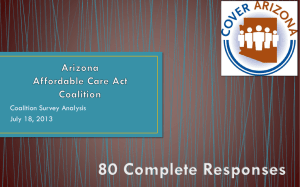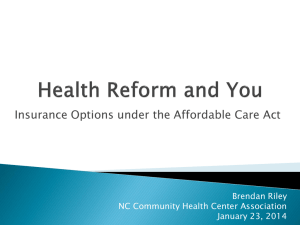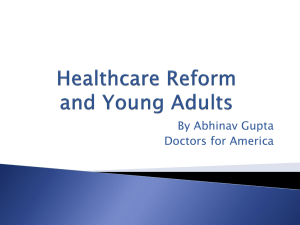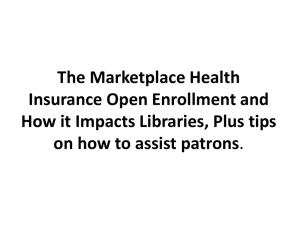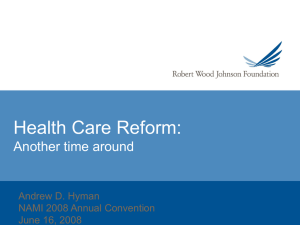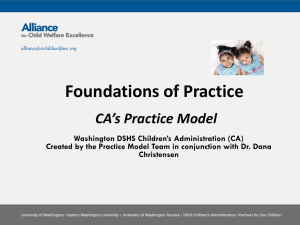Affordable Care Act Breakdown - Campus Life and Student Support
advertisement
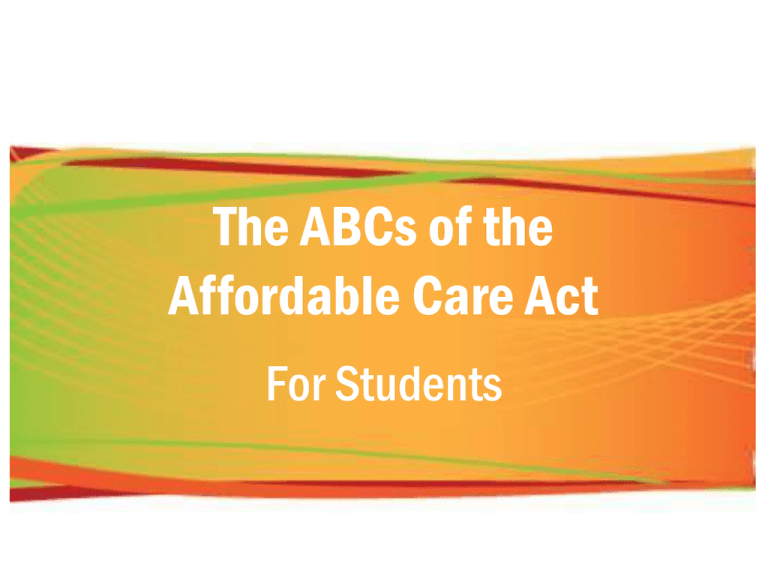
The ABCs of the Affordable Care Act For Students Topics to Cover ABCs of the ACA for Students Heathcare.gov What do you have access to, as a Student Options offered by AHP 2 Student Coverage and ACA What is more beneficial? Student health insurance or dependent coverage under their parents’ plans, or the Health Insurance Marketplace? How does ACA relate to Students? What are the 2014 ACA changes? What are the Essential Health Benefits? What is Minimum Essential Coverage? How will the Marketplace affect us? What are the key dates? 3 Definition of Student Health Insurance Coverage: A type of individual health insurance coverage. ABCs of Reform Institution of Higher Learning Health Insurance Issuer Written Agreement Must meet the following conditions: • Must be enrolled as a student (or a dependent of a student) in the institution. Offering dependent coverage is determined by the university • Does not condition eligibility for the health insurance coverage on any health status • Meets any additional requirements that may be imposed under state law • Eligibility decisions that determine student status under student health insurance plan coverage is up to the university and or the insurer 4 ABCs of Reform Student Plans under ACA: A type of Individual Coverage ACA-compliant student plans can satisfy the individual mandate requirements Student plans are not on the Marketplace Unique pooling for student plans 5 ABCs of Reform Minimum Essential Health Coverage 6 ABCs of Reform Tax Penalty • When filing 2014 taxes in 2015, individuals must indicate on their returns if they have health insurance coverage and, if not, pay a fine. • The individual penalty is the greater of $95 or 1 percent of income, rising to the greater of $695 or 2.5 percent of income, in 2016. The Congressional Budget Office estimates that less than 2 percent of Americans who don’t have health insurance will pay the fine. Rising Greater Greater 1% of Income 2.5% of Income $95 $695 7 ABCs of Reform “Mandate Exemptions” Included in individual coverage mandate but exempt from paying the penalty Excluded from individual coverage mandate • • Individuals who are not lawfully in the United States; • Individuals who are incarcerated; • Religious conscience objectors; or • Members of a health care sharing ministry. • Individuals who have “unaffordable coverage” (based on household income and required contributions for coverage); Individuals who have income below the threshold for filing a tax return; • Individuals who are members of an Indian tribe; • An individual whose first coverage gap experience of a calendar year lasts less than 3 months; or • Individuals who apply for and receive a hardship exemption from HHS. 8 ABCs of Reform Major ACA Changes in 2014 • Essential Health Benefits (EHB) will be included in every insurance plan • Prevention comes with no out-of-pocket cost (for in-network providers only) • There are no annual or lifetime limits • Simplified coverage descriptions will be available – summary of benefits and coverage (SBC) must be provided to students • Pre-existing conditions will be covered • ACA fees and taxes apply Effective upon renewal in 2014 9 What are the Essential Health Benefits? ABCs of Reform ACA lists 10 categories of essential health benefits (EHBs) that must be covered by non-grandfathered individual and small group plans in 2014. Each state benchmark plan sets the standard for EHBs in the state. In Illinois, Oklahoma and Texas, the state benchmark plan is a BCBS plan. 1. Ambulatory patient services; Plans that DO have to cover EHBs in 2014: 2. Emergency services; 1. Plans on the exchange 3. Hospitalization; 4. Maternity and newborn care; 2. 5. Mental health and substance use disorder services, including behavioral health treatment; Non-grandfathered, individual health care plans (Student Plans are considered individual for ACA purposes) 3. Non-grandfathered, fully insured small group health plans 6. Prescription drugs; 7. Rehabilitative and habilitative services and devices; Plans that DO NOT have to cover EHBs in 2014: 8. Laboratory services; 1. Self-insured/ASO health plans 9. Preventive and wellness services and chronic disease management; and 2. Grandfathered health plans 3. Large group health plans 10. Pediatric services, including oral and vision care. 10 ABCs of Reform What Are Marketplace Qualified Health Plans? 1. Provide essential health benefits package 2. Offered by licensed insurer 3. Certified by the exchange as “qualified health plans” No one is required to purchase health insurance through the Marketplace Premium tax credits and subsidies or cost-sharing assistance are only available to those that qualify and purchase on the Marketplace and may apply to select plans 11 Marketplace Coverage (Metallic Levels) ABCs of Reform Individual and insured small group plans, sold on and off the Marketplace, will have to meet one of four metallic levels that correspond to plan actuarial value (AV). Student plans are sold off exchange. Bronze Silver Gold 60% Actuarial Value 70% Actuarial Value 80% Actuarial Value Platinum 90% Actuarial Value 12 ABCs of Reform Summary of Benefits Coverage Requirements Under the Affordable Care Act, all health insurers and group health plans are required to provide consumers with a Summary of Benefits and Coverage (SBC). The SBC is a summary of the benefits and health coverage offered by a particular plan. The SBC is intended to provide clear, consistent, easy-to-understand descriptions that may make it easier for people to understand their health insurance coverage and for consumers to shop for and compare insurance plans. • The SBC is completed using a government-designed template, so the SBC will be consistent across all health insurance plans and will include: – – – – – What is covered by the plan What is not covered by the plan Cost-sharing provisions and exclusions Coverage examples A website and phone number for customer service and obtaining more information • The items in the SBC represent an overview of coverage; they are not an exhaustive list of what is covered or excluded. The full terms of coverage are located in the insurance policy. • SBC is listed on the AHP website at ahpcare.com/mwsu 13 ABCs of Reform • • • • ACA Toolkit FAQ Postcard Today’s Webinar Bcbstx.com/Reformandyou 14 Summary: Student Health Plans Effective upon renewal in 2014 • Individual mandate • Essential Health Benefits Required • No Pre-existing conditions exclusions for anyone • Unlimited lifetime maximums • Annual fee on health insurers, tax changes Federal Marketplace The Federal Health Insurance Marketplace is a new way to find quality health coverage. It can help if you don’t have coverage now or if you have it but want to look at other options. With one Marketplace application, you can learn if you can get lower costs based on your income, compare your coverage options side-by-side, and enroll. www.healthcare.gov 16 Student Health Insurance options as a student at Texas Woman’s University The TWU Student Health Insurance Plan (SHIP) is underwritten by Blue Cross and Blue Shield of Texas and administered by Academic Health Plans https://www.academichealthplans.com/twu/2013-2014/ 17 Advantages of Student Health Covers Health Center at 100% Includes Broad PPO Network Includes Global Emergency Services Has nurse line and additional features geared for students Lower cost than most Exchange Plans Easy enrollment procedure 18 Questions? Who Can Apply for Assistance? Appendix (Student Plans Not Eligible) • • • Must file an annual tax return and must purchase coverage on the Marketplace Citizens and legal residents may be eligible for premium tax credit to reduce the cost of coverage and/or cost-sharing subsidies based on income and family size. Incomes between 100% and 400% of federal poverty level (FPL) are eligible for a premium tax credit to reduce the cost of coverage on the Marketplace. 2013 individual FPL is $11,490. Marketplaces are required to tell enrollees about their eligibility for subsidies at the time they enroll. Cost-sharing subsidies* protect lower income people from high out-of-pocket costs at the point of service.** For example Up to 400% of FPL in 2013 • Up to $45,960 for individuals • Up to $62,040 for a family of 2 • Up to $78,120 for a family of 3 • Up to $94,200 for a family of 4 If a person’s income: • Is 100-150% ($11,490-17,235) the AV must be 94% • Is 150-200% ($17,235-$22,980) AV must be 87% • Is 200-250% ($22,980-$28,725) AV is 73% *Based on the second lowest-cost silver plan in their area for up to 250% of FPL ** Out-of-pocket cost savings only apply to Silver plans. 20 Appendix Health Plan Comparison Student Health Plans • More affordable • Easy enrollment • 100% coverage of eligible benefits through student health centers • Supports financial viability of Health Center • Broader network for all student metal level plans • Same EHB benefits as ACA & Marketplace options • University endorsed/supported Marketplace Health Plans • May be eligible for premium tax credit and cost-sharing assistance • More Selections 21


